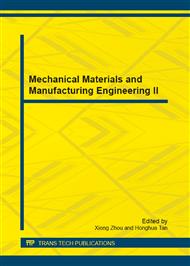[1]
D. Wang, X.S. Sun, Low density particleboard from wheat straw and corn pith. Ind Crops Prod. (2002) 15: 43-50.
DOI: 10.1016/s0926-6690(01)00094-2
Google Scholar
[2]
G. Nemli, S. Demirel, E. Gümüokaya, M. Aslan, C. Acar, Feasibility of incorporating waste grass clippings (Lolium perenne L. ) in particleboard composites. Waste Manage. (2009) 29: 1129-1131.
DOI: 10.1016/j.wasman.2008.07.011
Google Scholar
[3]
S. Sauter, Development composites from wheat straw. In: Proceedings of the 30th International Particleboard/Composite Material Symposium. WSU, 1996, pp, 197-21.
Google Scholar
[4]
E. Hagelberg, S. Lyytinen, in: Read Up on Reed (Ikonen, I., and Hagelberg, E., eds. ), Southwest Finland Regional Environment Centre. Turku, Finland 2007, pp, 94-101.
Google Scholar
[5]
G.S. Wang, High-yield cultivation techniques of reed. Modern Agricultural Sciences and Technology. (2007) 9: 30-31. In Chinese.
Google Scholar
[6]
G.P. Han, G. Wang, Z.G. Lui, Characteristics of reed material and manufacture technology of reed particleboard. For Prod Ind. (1995) 14(4): 37-38.
Google Scholar
[7]
G.P. Han, K.J. Umemura, M. Zhang, T. Honda, S. Kawai, Development of high-performance UF-bonded reed and wheat straw medium-density fiberboard. J Wood SCI. (2001)47: 350-355.
DOI: 10.1007/bf00766784
Google Scholar
[8]
G.P. Han, K.J. Umemura, S. Kawai, H. Kajita, Improvement mechanism of bondability in UF-bonded reed and wheat straw boards by silane coupling agent and extraction treatments. J Wood SCI. (1999) 45: 299-305.
DOI: 10.1007/bf00833494
Google Scholar
[9]
G.P. Han, C.W. Zhang, D.M. Zhang, K.J. Umemura, S. Kawai, Upgrading of urea formaldehyde-bonded reed and wheat straw particleboards using silane coupling agents. J Wood SCI. (1998) 44: 282-286.
DOI: 10.1007/bf00581308
Google Scholar
[10]
B.S. Xu, Practical Electron Microscopy. Southeast university press, Nanjing, 2008. In Chinese.
Google Scholar
[11]
China National Standard, 1999. GB/T 17657-1999. Test methods of evaluating the properties of wood-based panels and surface decorated wood-based panels. Standard Press of China, Beijing, China. In Chinese.
Google Scholar
[12]
R.Z. Pan, Plant Physiology. High education press, Beijing, 2004. In Chinese.
Google Scholar
[13]
China National Standard, 2003. GB/T 4897. 3-2003. Particleboard-Part 3: Requirements for boards for interior fitments (including furniture) for use in dry conditions. Standard Press of China, Beijing, China. In Chinese.
DOI: 10.3403/00943162u
Google Scholar
[14]
J. Hague, A. Mclauchlin, R. Quinney, Agri-materials for panel products: a technical assessment of their viability. In: Proceedings 32nd international particleboard/composite materials symposium. March 3-April 2, Washington State University, Pullman, WA, 1998, pp, 151-159.
Google Scholar
[15]
A. Reiterer, H. Lichtenegger, S. Tschegg, Fratzl. Experimental evidence for a mechanical function of the cellulose microfibril angle in wood cell walls. Phil. Mag. A, (1999) 79: 2173-2184.
DOI: 10.1080/01418619908210415
Google Scholar
[16]
I. B. Jusoh, P. Nzokou, P. Kamdem. The effect of silicone on some properties of flakeboard. Holz, als Roh-und, Werkstoff. (2005) 63: 266-271.
DOI: 10.1007/s00107-004-0550-6
Google Scholar


